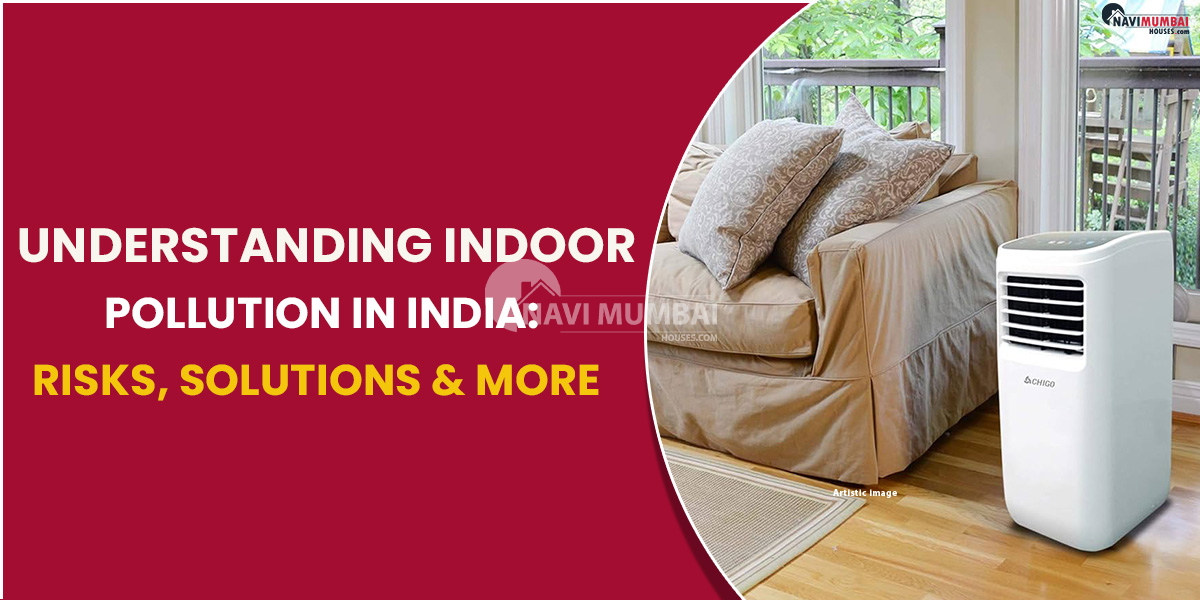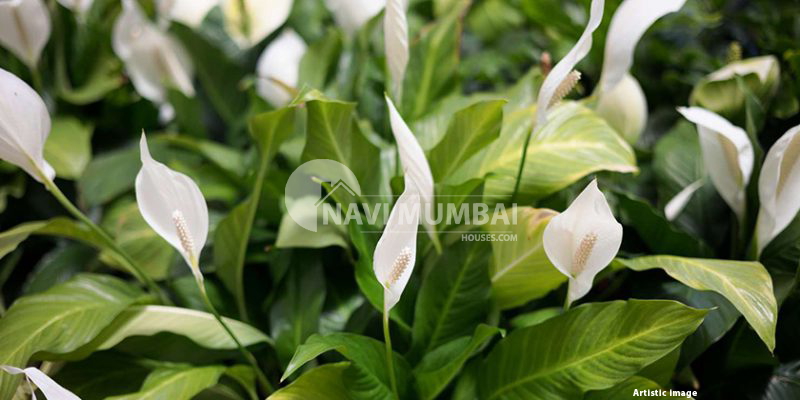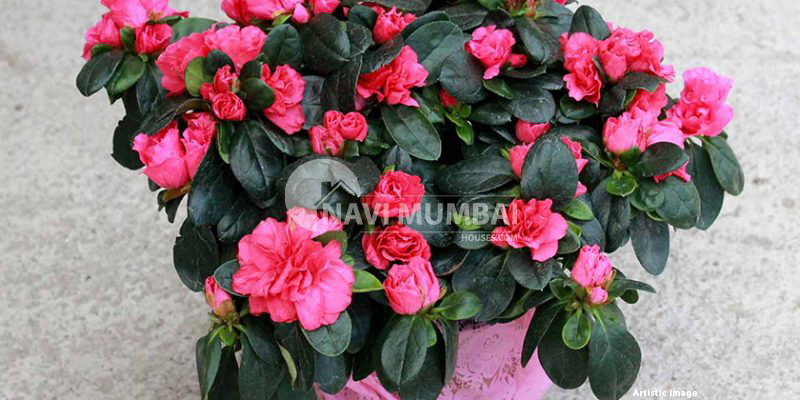
- November 10, 2023
- News
Understanding Indoor Air Pollution in India: Risks, Solutions & More
Indoor Air Pollution in India- In India, one of the main causes of preventable fatalities is indoor air pollution. The World Health Organisation (WHO) has noted in a report that three billion Indian women are at risk of fatal health effects from indoor pollution. Pollution can be decreased by using fewer fossil fuels, quitting smoking indoors, and adding purifying plants.
Are you searching flats for rent in Seawoods?
Winter has brought with it a heavy blanket of poisonous haze that has begun to affect major cities, leading to a low Air Quality Index. The government has requested that people limit their outside activity in order to lessen the effects of the bad air. But interior air pollution can be just as deadly as outside air pollution. Indians’ life expectancy is being shortened by five years due to indoor air pollution, per the Air Quality Life Index (AQLI) research. According to studies, this air pollution is the primary cause of 4.5 million deaths annually.
Aerosols, poor building construction, and insufficient ventilation are the main contributors to the startling rate of indoor air pollution. The risk of respiratory illnesses, heart problems, and strokes is increased by prolonged exposure to indoor air containing elevated amounts of carbon monoxide & carbon dioxide.
Understanding India’s indoor air pollution
India’s indoor air quality (IAQ) has gotten worse over time in both urban and rural areas. The amount of particulate matter (PM2.5) in indoor air has skyrocketed in India, beyond acceptable limits. Heart difficulties and respiratory illnesses are among the many health concerns that have increased as a result of poor IAQ.
A research conducted by the United Nations Environment Programme (UNEP) found that indoor air pollution ranges from 22 to 52 percent. The use of fragrance and the burning of fossil fuels have greatly boosted these levels. Thus, the National Clean Air Programme (NCAP) and the Green Rating for Integrated Habitat Assessment (GRIHA) have recommended using air purifiers and enough ventilation to lower the levels in order to solve the problem.
Common indoor air pollutants
The following list of typical indoor air contaminants and how they affect health and wellbeing:
Mold
A typical indoor air contaminant that grows in moist, poorly ventilated spaces is mould. These can be seen growing on a variety of surfaces, such as HVAC systems, walls, and ceilings. Long-term mould exposure causes allergies and respiratory problems.
Tobacco smoke
The main source of tobacco smoke indoors is the indoor use of tobacco products like cigars and cigarettes. The dangerous substances in smoke, known as carcinogens, can cause lung cancer, heart disease, and a variety of other respiratory conditions.
Carpets
Although they are aesthetically pleasing and comfortable, carpets can also hold allergies, dust, and pet dander. These need to be maintain on a regular basis because they might aggravate symptoms of allergies and asthma.
Pet dander
Household pets like cats and dogs lose skin cells, fur, and saliva, which results in the production of pet dander. For those who are allergic to them, these danders can cause asthma attacks and allergies. Better indoor air quality can be anticipate, nevertheless, with routine cleaning and air filtration.
Household products
Common household items that release volatile organic compounds (VOCs) into the interior air include paints, air fresheners, and cleaning supplies. These VOCs cause indoor air pollution, which irritates the eyes, throat, and headaches people suffer.
The best methods for improving indoor air quality
Appropriate ventilation methods
To a large degree, increasing indoor air quality requires proper ventilation. Indoor air pollution can be two to five times worse than outside air pollution, according to the US Environmental Protection Agency (EPA). Simple solutions like opening windows and utilizing exhaust fans should be use to stop this. These aid in clearing the air of impurities and stale air, which revitalizes it. A healthy atmosphere is promoted by adequate ventilation, which lowers the concentration of indoor air pollutants, such as carbon dioxide and volatile organic compounds (VOCs).
Air purifiers: their importance
An air purifier is a machine that filters out airborne particles like smoke, pollen, dust, and other contaminants. It effortlessly eliminates air contaminants by drawing stale air from the surrounding atmosphere. High-efficiency particulate air filters, or HEPA filters, are the most widely use kind of filters. The threads of this filter catch tiny particles. Furthermore, certain filters have activated carbon built in, which can absorb particles that cause odours and UV rays, lowering the pollution level.
Natural techniques for purifying the air
Indoor plants that naturally purify the air include spider plants and peace lilies. Certain plants, such aloe vera, golden pothos, English ivy, and weeping can readily eliminate indoor air pollutants like formaldehyde, benzene, and ammonia, according to NASA’s Clean Air Study. Indoor air pollutants are greatly reduce by these plants.
Controlling humidity’s role
To guarantee improved indoor air quality, it is imperative to maintain ideal levels of indoor humidity. The ideal range for indoor humidity is 30 to 50 percent, according to the EPA. Dust mites and mould, two common indoor air pollutants, are less likely to survive and spread when humidity is properly controlled. Better air quality can be achieved by using dehumidifiers and humidifiers to help manage humidity.
Selecting an appropriate air purifier
Popular air purifiers that are suppose to lower indoor air pollution levels include the following ones:
| Air purifier type | Price (Rs) |
| Mi Air Purifier | 9,500 |
| Honeywell Air Touch Air Purifier | 12,900 |
| Dyson Pure Cool Link Tower Air Purifier TP03 | 28,000 |
| Phillips High-Efficiency Air Purifier AC2887 | 19,000 |
| Levoit Air Purifier with True HEPA Filter | 17,000 |
| Blueair Blue Pure 211+ Air Purifier | 20,900 |
| Coway AP-1512 HH Mighty Air Purifier | 29,946 |
Index of indoor plants that work well in Indian households
These 11 well-liked houseplants are appropriate for Indian homes:
Aloe vera
Aloe Vera eliminates formaldehyde and benzene from the air, soothing the skin in the process. Well-drained soil and indirect sunlight are ideal for its growth. It thrives in slightly shaded areas with moist soil and has antibacterial qualities.

Golden Pothos
Indoor air pollution can be effectively eliminated using Golden Pothos. It requires little upkeep and grows well in indirect light. It grows quickly and maintains its green colour even when kept in the dark.
Peace Lily
Peace Lilies are great interior air purifiers; they eliminate formaldehyde, ammonia, and other contaminants. They clear the breathing room by favoring moderate watering and low light.

English Ivy
English ivy is well-known for its ability to purify the air by lowering pollutants and mould in the atmosphere. It needs steady hydration and bright, indirect light, but standing water should be kept out of its way.
Weeping Fig
You can use Weeping Figs in the room to absorb toxins from the carpet, curtains, and furniture. It should, therefore, be positioned close to a window so that it receives both direct and indirect light.
Azalea (Rhododendron Simsii)
Azaleas are an excellent choice for indoor plants since they clean the air of impurities like plywood and foam. Furthermore, these are easily grown in strong indirect light and prefer soil that is continually moist.

Warneck Dracaena
Toxins including formaldehyde, trichloroethylene, and xylene are eliminate from the environment by these towering plants. They are low maintenance, grow well in moderate light, and need to be watered frequently.
Bamboo Palm
Bamboo palms are great indoor plants to get rid of formaldehyde and benzene from the air. Regular watering and bright, indirect light are prefers for these plants.

Snake Plant
Snake plants are great air filters because they absorb benzene and formaldehyde. They don’t need to be watered frequently; however, they do not tolerate much light.
Money Plant
Money plants require little maintenance and eliminate pollutants from the air. These plants need modest watering and do best in indirect light.

Green Spider Plant
Formaldehyde and xylene can be effectively eliminate from the atmosphere by spider plants. These plants prefer slightly damp soil and grow best in indirect light.
The risks of smoking inside
Second-hand smoke is a hazardous condition that arises when someone smokes inside of closed premises. Nonsmokers in this condition are expose to toxic vapours that negatively impact their health, especially children and the elderly. The main risks connected to smoking inside are as follows:
- Adults who are expose to secondhand smoke have a 25–30% increase risk of heart disease and stroke.
- Lung cancer and asthma can both be brought on by prolonged exposure to cigarette smoke.
- Indoor smoking has been linked to delayed lung development, asthma, bronchitis, and middle ear infections in children.
Policy from the government pertaining to indoor air quality
Ujjwala Yojana Pradhan Mantri (PMUY)
One of the main sources of indoor air pollution is the burning of biomass fuels for cooking. In an effort to reduce pollution, the government provides families in both rural and urban regions that fall below the poverty line (BPL) with discounted LPG petrol. By encouraging the use of LPG instead of conventional cooking techniques, this programme lowers the amount of indoor air pollution. According to a WRI assessment, the Ujjwala Yojana has reduced the number of deaths in India by 13 percent, averting 1.5 lakh deaths. Additionally, 1.8 million tonnes of fine particulate matter have been avoid because to this approach.
Programme for National Clean Air (NCAP)
The goal of the NCAP programme was to lower outdoor air quality by lowering total air pollution levels. Through the use of air quality monitoring, this effort seeks to enhance the quality of the air in Indian cities. To preserve good indoor air quality, building designs must adhere to a number of rules and regulations that specify appropriate ventilation, hygienic cooking, and living spaces.
GRIHA
One of the leading assessment groups, GRIHA, has released a number of guidelines aimed at enhancing indoor air quality. According to the GRIHA’s advisories, using clean fuels and cutting back on smoking and cologne use inside enclosed spaces are the best ways to maintain indoor air quality. They have also recommended HVAC (heating, ventilation, & air conditioning) control and management, air purifier installation, and IAQ-improving plants.
In conclusion, India’s declining indoor air quality has turned into a serious health issue. High levels of indoor air pollution strain government health systems in addition to exacerbating health problems. Owing to the potential for danger, the problem necessitates a multifaceted strategy for cutting back on fossil fuel consumption, increasing ventilation, and cleaning indoor plants. Together, these initiatives will not only improve the quality of the air, but also people’s lives in general.
You’re looking for Projects in Kalyan have the Best Properties In Thane Like Ready to Move:https://navimumbaihouses.com/properties/search/kalyan/
If you want daily property update details please follow us on Facebook Page / YouTube Channel / Twitter









